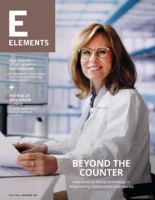The expansion of pharmacy schools in the United States has caused alarm for many people in the profession. Major concerns are centered on the establishment of proper resources, like educational faculty and staff in these schools and their sustainability, as well as available sites for rotation and residency. The increase in pharmacy schools will also have an effect on the many economical changes that will likely occur in the near future, such as healthcare reform and job market saturation.
Most importantly, there are concerns about how the high number of pharmacy school graduates will learn about and respond to the numerous changes predicted in the future of the profession. Pharmacy is quickly becoming less focused on strictly dispensing medication and is instead working toward direct pharmacist involvement in the healthcare team of each patient.
By the numbers
Many believe that this increase in pharmacy schools was a direct result of the pharmacist shortage in the 1980s and 1990s. Another driving factor in the growth of pharmacy schools is the fear of another shortage brought on by the impending retirement and aging of the Baby Boomer population, which make up approximately 76 million men and women. But, many also believe that it’s not the population numbers that gave rise to so many new schools of pharmacy. Instead, it’s the numbers that make up the amount of tuition dollars.
A 2010 opinion article in the Connecticut Post written by former American Association of Colleges of Pharmacy (AACP) president Nicholas G. Popovich said, “Pharmacy school tuition can cost anywhere from $100,000 to $350,000 depending on the program.” The broad appeal of the pharmacy profession to students and the high tuition rate make the implementation of pharmacy schools at private and for-profit universities noteworthy. Popovich also said, “We believe that these academic institutions…are creating pharmacy programs to take advantage of the premium tuition students must pay to earn a pharmacy education.”
As of February 2012, there were 129 accredited (full or candidate status) schools of pharmacy in the United States. In July 2010, there were 115 similarly accredited schools. In the mid-1980s, the number of pharmacy schools stood at 72 institutions, marking the increase of pharmacy schools today at approximately 79 percent. In almost 30 years, this huge increase of students and practitioners of pharmacy undoubtedly reflects the many changes that have occurred within the profession.
Academic issues
While schools seem to have few problems getting students to enroll in pharmacy programs, an issue is who will instruct these students and where they will rotate during their time in school. Faculty shortages across the country are contributing to these problems. The amount of years of school necessary for one to teach at the professional level is approximately eight or more.
Also, smaller salaries and recruitment by private institutions, like hospitals or insurance companies, and government positions account for the faculty shortage at many schools. It is interesting to note that many professors have been called to teach after retiring from the retail pharmacy environment, bringing both experience and knowledge to the classroom. However, students must also venture outside the classroom before they graduate with their Pharm.D. degree. Apprehension about the availability of quality rotation sites and willing preceptors at these sites is a concern that several pharmacy associations and organizations are addressing on an ongoing basis.
Every pharmacy school’s curriculum must include Introductory Pharmacy Practice Experiences (IPPE) courses. Additionally, in the final year of school, students must complete Advanced Pharmacy Practice Experiences (APPE) courses. These important courses make up a significant portion of the pre-and post-graduate curriculum. For pharmacy students interested in community pharmacy, their IPPE and APPE experiences allow them to further explore their specific interest in this important area of the pharmacy profession, in a way that no lecture or classroom experience can.
Practical experience
The University of Missouri-Kansas City (UMKC) School of Pharmacy in Kansas City, Missouri recognizes the importance of practical experience for its students. Peggy Kuehl, Pharm.D., FCCP, BCPS, a clinical associate professor and the community pharmacy coordinator and director of the community pharmacy residency program at UMKC, said that UMKC requires eight ‘core competencies’ for APPE students at any of the advanced community sites. The UMKC core competencies requirements include health screenings, immunization delivery, medication adherence assessment, medication therapy management, and provision of written therapy recommendations and/or documentation of care to patient’s physician, among others.
“For students entering a post-graduate residency, it’s important to remember they are being hired to learn,” Kuehl said. “They’re encouraged to create and explore new programs and practices at these pharmacies. We want our residents to not only replicate the services they’re using at these residency sites, but to be leaders in the innovation of new services that will help move the profession forward.”
Changing roles
Students aren’t just taking classes in medicinal chemistry; they’re also getting an experiential education with courses such as Introductory Pharmacy Practices. These courses involve far more patient-interaction. They also touch on one of the most important changes the profession is experiencing: a switch from strictly dispensing to more pharmacist involvement in healthcare. A 2010 discussion paper by the American Pharmacists Association (APhA) and the American Society of Health-System Pharmacists (ASHP) addressed the issue of the changing roles in pharmacy directly:
“It is likely that fewer pharmacists will be needed for traditional dispensing and drug product distribution activities because of automation, standardization of dispensing and distribution processes, and expanded use of auxiliary workers. While there is immense need for pharmacists to engage in medication therapy management and other clinical activities, current reimbursement systems are stifling the growth of the numbers of practitioners in these areas. It is uncertain how quickly the financial basis for pharmacy practice will change.”
The paper noted the idea of pharmacists becoming more directly involved in patient-care with “more emphasis…placed on the team-based approach to patient care.” Many others have also forecasted this change for the pharmacy profession and envision a future involving a patient-physician-pharmacist collaborative relationship that helps prevent negative healthcare outcomes, thereby lowering costs and improving overall health nationwide.
Getting involved
The need for rotation sites and preceptors is evident, so how can an independent pharmacy like yours get involved? First, interested pharmacists must decide if they have the time to put in with each student. First through third-year students doing a short rotation will undoubtedly have many questions, so pharmacist involvement is absolutely necessary, and also for the evaluations and assignments the students may have.
In the higher-level residency programs, it’s important to note that students, while on the payroll, cannot perform as cheap labor. For instance, through UMKC certain requirements include the students writing a collaborative drug-theory protocol with a physician and the implementation of this program, along with a researched-and-written business plan for this new service. “We look for very progressive sites for residencies, pharmacies that are changing and growing, just like the profession,” Kuehl said.
Afton Wagner, Pharm.D., National Community Pharmacy Association (NCPA) director of management and student affairs, suggests that community pharmacies interested in becoming rotation or residency sites should contact the NCPA or the schools of pharmacy in their area. “Patient care is central to community pharmacy,” Wagner said. “When students are able to interact with patients in a unique, personal way, they gain experience that they wouldn’t have otherwise.”












